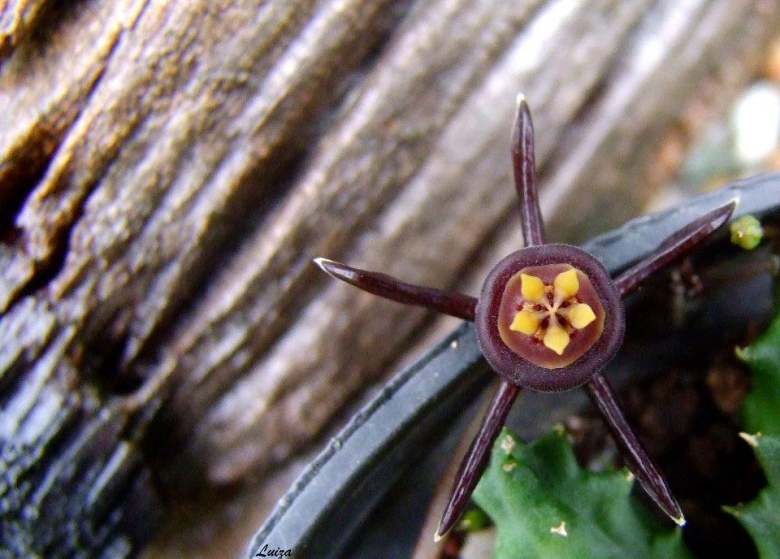Accepted Scientific Name: Duvalia caespitosa var. compacta (Haw.) Meve
Pl. Syst. Evol., Suppl. 10: 59. 1997

Stapelia compacta (Duvalia caespitosa var. compacta) Photo by: Luiza Ferreira
Origin and Habitat: Republic of South Africa (Northern Cape, Western Cape, Eastern Cape: Namaqualand, Great Karoo).
Synonyms:
See all synonyms of Duvalia caespitosa
Description: Duvalia caespitosaSN|26513]]SN|26498]] var. compacta (Duvalia compactaSN|26498]]SN|26504]]) is a distinctive variety of Duvalia caespitosaSN|26504]]SN|26498]] with smaller stems and flowers. In both var. compacta and var. caespitosa the stems are four- or five-angled but the former has broad and short tubercles on the stems being more closely placed and more abruptly apiculate. The blooms of D. compacta, developed from the centers of the stems, are solitary or up to five together and dark chocolate-brown. Only with the aid of a lens can the few minute hairs at the bases of the petal margins be seen. The inner corona is dull orange-red, the outer brownish-red and somewhat five-sided. Its flowers closely resemble the minutely ciliated forms of Duvalia hirtellaSN|26498]]SN|26513]], but are much smaller.
Stems: 1.5-5 (or under cultivation up to 9) cm long, 1-2.5 cm thick, globose or oblong, 4- to 5-angled, the angles formed of series of rounded apiculate tubercles, dull green, compact.
Leaves: Rudimentary 1.5-4 mm long.
Inflorescences (dichasia): 1–5 flowered at about the middle of the young stems or close to the stem tip.
Flowers: Successively developed. Pedicels 12-18 mm long. Sepals 2-3 mm long, lanceolate-ovate, acute. Corolla 16-24(-28) mm in diameter, entirely dark chocolate. Corolla lobes free, very spreading, with slightly recurving tips, (6-)8-13 mm, 4-6 mm wide, lanceolate, acute, replicate to their base into vertical plates about 2 mm deep, margins mostly glabrous or basally ciliate at the base only with a few very minute simple hairs, 0.05-0.1(-0.6) mm long, only visible under a lens. Annulus small, 3-8 mm in diameter, 1.2-2.5 mm high, with a narrow rim around the corona, margin glabrous or very minutely papillate. Hairy papillae 0.03-0.1 mm long. Corona disc 3.5-6 mm in diameter. Outer corona 2.5–3 mm in diameter, obscurely pentagonal, less flat than in many species, brownish-red. Inner corona-lobes dull orange-red.
Fruits (paired follicles): 7-12 cm long.
Subspecies, varieties, forms and cultivars of plants belonging to the Duvalia caespitosa group
 Duvalia caespitosa (Masson) Haw.: has purple-brown star shaped flowers with five fleshy, narrow 'petals'. It is extremely variable and forms a complex. Distribution: Northern, Western and Eastern Cape(summer rainfall areas).
Duvalia caespitosa (Masson) Haw.: has purple-brown star shaped flowers with five fleshy, narrow 'petals'. It is extremely variable and forms a complex. Distribution: Northern, Western and Eastern Cape(summer rainfall areas). Duvalia caespitosa var. compacta (Haw.) Meve: has smaller stems and flowers. Distribution: Northern Cape, Western Cape, Eastern Cape: Namaqualand, Great Karoo.
Duvalia caespitosa var. compacta (Haw.) Meve: has smaller stems and flowers. Distribution: Northern Cape, Western Cape, Eastern Cape: Namaqualand, Great Karoo. Duvalia caespitosa subs. pubescens (N.E.Br.) Bruyns: has pubescent corolla surface. Distribution: Southern Namibia, RSA(Northern Cape. Western Cape)north of the Olifants (winter rainfall areas).
Duvalia caespitosa subs. pubescens (N.E.Br.) Bruyns: has pubescent corolla surface. Distribution: Southern Namibia, RSA(Northern Cape. Western Cape)north of the Olifants (winter rainfall areas).- Duvalia caespitosa subs. vestita (Meve) Bruyns
 Duvalia reclinata (Masson) Haw.: not readily distinguishable from the type, if not for the geographical provenance. Distribution: Cape Province, Central regions and in the coast region near Ladismith.
Duvalia reclinata (Masson) Haw.: not readily distinguishable from the type, if not for the geographical provenance. Distribution: Cape Province, Central regions and in the coast region near Ladismith.
Bibliography: Major references and further lectures:
1) N. E. Brown “Flora Capensis” Vol 4, 1909
2) Bruyns, P.V. “Stapeliads of southern Africa and Madagascar” (Vol. 1, pp. 1-330). Umdaus Press, Pretoria. 2005
3) Focke Albers, Ulrich Meve “Illustrated Handbook of Succulent Plants: Asclepiadaceae: Asclepiadaceae” Volume 4 Springer, 2002
Cultivation and Propagation: Duvalia caespitosaSN|26498]]SN|26498]] var. compacta is an easy obliging blooming plant when mature, that it is happy in any average succulent house.
Potting:Since roots are quite shallow, use a soft and incoherent cactus mix or add extra perlite or pumice to regular soil potting soil, and clay pots help the plants to dry out between watering.
Waterings: Duvalias require moderately watering through the growing season but enjoy plenty of water and some fertiliser in hot weather, this helps them to flower freely. Water more sparingly in winter according to temperatures. But, as with most asclepiads, it is unwise to leave them wet in cold weather.
Fertilization: Fertilizers for succulent plants must be rich in potassium, but poor in nitrogen, to avoid the plants from developing excess vegetation, which is easily attacked by fungal diseases.
Sun Exposure: As with many succulents, they prefer to grow in the light shade of scrubby shrubs or between rocks where they get some shade during the day. In summer it is advisable to position this plant in a partially shady place, where it is exposed to direct sunlight only during the coolest hours of the day.
Hardiness: These plants don't like cold weather, therefore in the Spring it is best to set them outside only when the temperatures are above 15°C. Can endure temperatures below 5°C for short period, but only if the soil stays completely dry.
Pest and diseases: Duvalias species vary in their susceptibility to rotting, but are generally fairly easy to grow, especially if kept pest-free. They are very susceptible to stem and root mealy bugs, and damage from these may well initiate fungal attack. If you do have problems with a stem or with basal rotting, you can reliably isolate the healthy parts, dry them off, and re-root them in moist compost.
Cultural Practices: Re-pot every 2 years.
Propagation: Easiest with stem cuttings. Allow cuttings to dry a day before planting. Stems must be laid (Not buried) on gritty compost and will then root from the underside of the stems. It can also be increased from seeds sowing in spring in moist, sandy peat moss. Barely cover seeds. Seeds germinate quickly.











